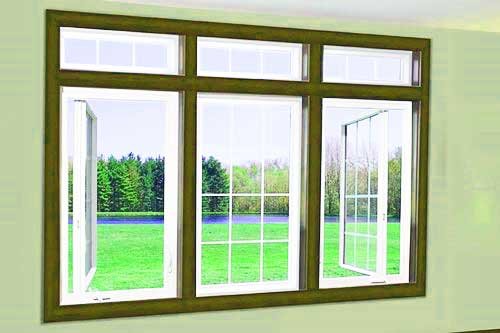Transforming a room into a beautifully illuminated and well-ventilated space is easily achievable with the right windows. The multitude of factors to consider, including styles, colors, materials, forms, sizes, and technological advancements, can make the process of selecting the right windows for your home a bit overwhelming. However, making informed choices can not only enhance the architectural character of your home but also improve energy efficiency, boost its value, and flood your interiors with light. Replacing old windows with energy-efficient, double-pane alternatives can save you money on heating and cooling bills while adding to your home’s curb appeal.

Factors to Consider When Choosing Windows:
- Appearance:
The aesthetic impact of windows on both the interior and exterior of your home is significant. Opt for windows that complement your home’s architectural style, enhancing both the inside and outside appeal. Consider features like retractable screens for unobstructed views and increased natural light. - Energy Efficiency:
Windows play a crucial role in a home’s temperature regulation. Choose energy-efficient windows to save on energy costs. Factors such as window design, glass type, glazing, and seals influence energy efficiency. Explore options like tinted or Low-E glass, insulated glass units (IGUs), and thermal breaks to enhance efficiency. - Installation:
Window installation can range from simple to complex. If considering professional installation, inquire about installation options before purchasing your windows to ensure a seamless process. - Function:
Windows serve various functions beyond letting in light. Consider the role each window will play in different rooms—whether as a gateway, a fixed and ornamental feature, or an emergency exit. Test the ease of use, cleanliness, and maintenance of different window styles before making a choice. - Location:
The orientation of your windows and their exposure to sunlight and weather should be taken into account. Oversized windows without proper sun control can lead to overheating during summer. Consider options like between-the-glass shades or Low-E coatings for better sun protection and privacy. - Maintenance:
Maintenance, especially for exterior windows, is crucial. Opt for nearly maintenance-free materials like aluminum cladding to ensure long-lasting aesthetics. Check if windows are designed for easy cleaning from the inside and if hardware options are user-friendly.

Popular Window Frame Materials:
- Wood:
Wooden frames are versatile with a polished, elegant appearance. While high-quality wood frames are durable, they require regular maintenance such as painting or polishing. - Aluminium:
Aluminum frames are lightweight, durable, and customizable but lack adequate thermal insulation. Regular maintenance is essential to prevent anodization issues. - uPVC:
Unplasticized Polyvinyl Chloride (uPVC) frames require minimal upkeep, are heat-resistant, and UV-resistant. However, they may not last as long as wood or aluminum frames. - Fibreglass:
Fiberglass is environmentally friendly, durable, and weather-resistant. It expands and contracts like glass, reducing air leakage and enhancing energy efficiency. - Composite:
Made from wood shavings and plastic resins, composite windows offer a wood-like appearance with minimal maintenance. They are a green option due to the use of recycled plastics. - Vinyl:
Cost-effective and energy-efficient, vinyl windows are a popular choice when installed professionally.

Various Window Styles:
1. Casement Windows: A Door-Like Opening
Casement windows present a door-like opening with a side-hinged sash—frame pieces encircling glass panels. This style allows the window to swing open, either inwards or more commonly, outwards.

2. Sliding Windows: Horizontal Movement
Sliding windows operate by moving horizontally along rails in either direction. This straightforward design offers simplicity and ease of use.

3. French Windows: Elegance and Versatility
French windows, or doors, are employed on outside walls to create an open connection to balconies, terraces, and patios. Within a home, they serve to divide spaces. Typically crafted with glass panels set within wood frames, this style imparts a classic and elegant appeal to the room.

4. Bay Windows: Unique Angular Protrusion
A Bay window consists of three windows joined at 30-45 degrees, protruding outwards. Each glass panel can be designed to open outwards like casement windows or remain fixed, offering both versatility and aesthetic charm.

5. Top Hung Windows: Hinged at the Top
Hinged at the top of the frame, top-hung or awning windows open outwards. This style is often used in conjunction with other window types or positioned atop doors, particularly in bathrooms.

6. Louvered Windows: Humidity-Friendly Design
Louvered windows feature multiple slats of glass, wood, or vinyl arranged horizontally and parallel to a frame. Cranks or handles are employed to open and close them. Also known as Jalousie windows, this style is particularly useful in humid spaces like restrooms or in regions with harsh summer climates.

7. Skylights: Bringing the Outdoors In
Skylights offer direct access to the roof and are seamlessly integrated into the ceiling. Selecting leak-proof designs and incorporating heat-resistant coatings is crucial when considering skylights for your space.

8. Hopper Windows: Ideal for Limited Spaces
Hopper windows have hinges on the bottom of the sashes, making them well-suited for smaller spaces. They can be opened by either pushing outward or pulling inward, providing flexibility in functionality.

9. Tilt and Turn Windows: Hybrid Functionality
Combining elements of hopper and casement windows, tilt and turn windows open from the top with hinges at the bottom, allowing for inward turning. The dual-hinge system facilitates both top and side openings, providing versatility in ventilation options.

10. Picture Windows: Embracing Natural Light
Also known as fixed windows, the picture window style is ideal for maximizing natural light in a space. This design, which does not open, serves to frame breathtaking views and creates a focal point within the room.

Conclusion
Choosing the right windows involves careful consideration of aesthetics, energy efficiency, installation, function, location, and maintenance. By understanding the various materials and styles available, homeowners can make informed decisions that enhance both the visual appeal and functionality of their homes.


